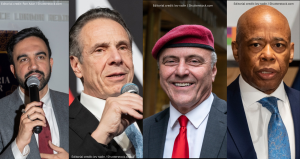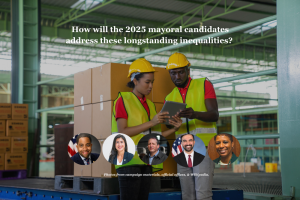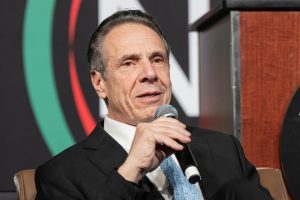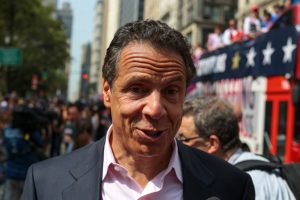By Esther Claudette Gittens
The final four candidates in the 2025 New York City mayoral race—incumbent Mayor Eric Adams, former Governor Andrew Cuomo (Independent), Zohran Mamdani (Democratic nominee), and Republican Curtis Sliwa—covering the pros and cons as portrayed by the media and from their own statements. This overview digs into background, platforms, strengths, vulnerabilities, and how they stack up heading into November’s general election.
- Eric Adams (Independent; currently in office)
Strengths & Media Portrayals
- Blue-collar credentials / working-class appeal: Adams has crafted a strong narrative around his modest upbringing, emphasizing his connection to Black and Latino working-class communities. His campaign rally at City Hall positioned him as a practical champion for these groups
- Accomplishments touted: Highlights include reductions in crime rates and new affordable housing projects—key achievements he leans into.
- Strong donor support: Alarmed business and real estate leaders see Adams as the bulwark against progressive policies and are rallying behind him
- Adaptable campaign strategy: Running independently with new ballot lines—“EndAntiSemitism” and “Safe&Affordable”—allows him to broaden his coalition beyond the Democratic fold
Weaknesses & Criticisms
- Scandal shadow: His tenure has been marred by a federal bribery indictment (later dismissed), FBI scrutiny over Turkish-government-linked approvals, and the controversial DOJ dismissal deal—all leaving a cloud over his judgment and governance
- Low favorability: An October 2024 Marist poll pegged his approval at just 26%, with nearly 70% of voters wanting him to resign.
- Independent run challenges: He lacks PSA public funds, institutional backing, and faces poor poll numbers—running outside a major party while under scandal-related scrutiny.
- Polarized trust: Critics across the city see him as divisive. His campaign notes past hiring missteps and vows to rebuild trust
- Andrew Cuomo (Independent – “Fight and Deliver”)
Strengths & Media Portrayals
- Experience and establishment support: A former three-term governor with significant name recognition, backed by centrist endorsements from figures like Bill Clinton and Michael Bloomberg.
- Strong fundraising: Raised over $1.5 million in the first two weeks of his campaign, an indicator of political infrastructure and donor confidence.
- Policy resume: Advocates for policy priorities like public safety, wage increase, large-scale housing, and moderate tax relief align with centrist-leaning voters.
Weaknesses & Criticisms
- Legal clouds linger: His legacy is still plagued by sexual harassment allegations, federal investigations tied to his gubernatorial term—including nursing home policies—and ongoing lawsuits.
- Perceived avoidance: Cuomo has been criticized for sidestepping tough debate questions and dodging accountability—a media narrative that undermines his readiness.
- Voter fatigue and backlash: The NYT editorial board explicitly advised against ranking him due to weariness over his tenure and controversies.
- Vote-splitting risk: His independent campaign could fracture the centrist or moderate vote, potentially opening the path for progressives or Adams to capitalize.
- Zohran Mamdani (Democratic nominee, Democratic Socialist)
Strengths & Media Portrayals
- Progressive momentum: The 33-year-old upstart pulled off a stunning primary upset over Cuomo, signaling a powerful grassroots and younger voter coalition.
- Bold affordability platform: His proposals—rent stabilization or freeze, free public transit and buses, wealth taxes, city-run grocery stores—address NYC’s cost-of-living crisis directly.
- Strong endorsements: Backed by Senator Bernie Sanders and Rep. Alexandria Ocasio-Cortez, underscoring his credibility within the progressive wing.
- Environmental justice: Emphasizes climate resilience, green retrofitting, and upzoning—broadening his appeal among eco-conscious urban voters.
Weaknesses & Criticisms
- Alarm among real estate and business: Rent freeze proposals have prompted industry hysteria, emergency meetings, and fears of capital flight—developers view him as a threat.
- Risk of radicalism label: Critics paint his platform as financially reckless or utopian. Adams frames it as “Twitter politics,” while the real estate pushback highlights serious macroeconomic concerns.
- Experience questioned: While he has legislative achievements (four bills passed), detractors argue he lacks executive-level credentials especially when compared to Adams or Cuomo.
- Potential coalition fragility: Young and progressive base may not translate into widespread support across blue-collar, immigrant, and moderate electorates.
- Curtis Sliwa (Republican nominee)
Strengths & Media Portrayals
- Law-and-order messaging: Known for founding the Guardian Angels, his platform centers on public safety and support for police—resonating with traditional conservative voters.
- Clear party positioning: Sliwa holds the formal GOP endorsement, ensuring coordination and party-based resources for his campaign.
Weaknesses & Criticisms
- Insufficient polling: Consistently polling in single digits—barely visible relative to the four-way dynamic.
- Vote-splitting risk: Some Republicans may rally behind Adams, forcing Sliwa to split a small base even further, threatening to undercut conservative representation.
- Limited appeal: His backing remains narrow, unlikely to gain traction in a city dominated by Democrats and progressive independents.
General Election Dynamics: Four-way vs. Fractured Coalitions
Major outlets like Reuters and Axios underscore the unique four-way nature of this race:
- Mamdani vs. Adams, with Cuomo and Sliwa as third-party spoilers.
- Polling suggests Mamdani could lead if Cuomo stays, but Adams gains a boost if Cuomo drops out.
- Business elites strategize to split or unite around non-progressive candidates to block Mamdani’s socialist-leaning platform.
- Ranked-choice voting looms large: dynamic vote transfers in second-preference ballots could determine the outcome—making eliminations and alliances vital.
Head-to-Head Summary
| Candidate | Strengths | Vulnerabilities |
|---|---|---|
| Eric Adams (I) | Proven leadership in crime/housing, working-class appeal, business backing | Legal baggage, low approval, campaign funding challenges |
| Andrew Cuomo (I) | Experience, moderate policies, fundraising capability | Past scandals, voter fatigue, debate criticism, vote-splitting risk |
| Zohran Mamdani (D) | Youthful insurgent, progressive agenda, activist endorsements | Radical label, economic backlash, limited executive experience |
| Curtis Sliwa (R) | Law-and-order stance, established party backing | Low polling, narrow appeal, overshadowed in multi-candidate race |
Candidate-by-Candidate Deep Dive
Eric Adams
- Media framing: Portrayed as the pragmatic incumbent, successful in transit safety, crime reduction, and pragmatic housing, but overshadowed by scandal.
- Campaign messaging: Emphasizes “practical governance” over Mamdani’s progressive “silver spoon” idealism.
- Strategic pivot: His independent run reflects a bet on combining working-class credibility with centrist business support. The lack of party-first resources could hamper ground operations.
Andrew Cuomo
- Media framing: His entry is a flashback to establishment efforts, presenting a familiar centrism—touted for experience but criticized for being tainted .
- Policy vs. past: His moderate agenda is overshadowed by longstanding controversies, including COVID policies and legal probes. He’s now a risk-averse figure struggling for trust.
- Ballot-line gamble: Cuomo’s “Fight & Deliver” line secures ballot access, but media cover suggests he is testing waters—unsure whether to vigorously campaign
Zohran Mamdani
- Media framing: The face of generational change—his win across Queens and youth-led campaigns fueling optimism. Applauded for visionary climate policies and city affordability.
- Policy boldness: Rent freeze, wealth taxes, free transit, green schools—all bold hooks. But developers warn this agenda “could trigger panic and capital flight” .
- Electability concerns: Framing issues: Can his energy translate citywide? Can he turn momentum into broad coalitions beyond progressives?
Curtis Sliwa
- Media silence: He’s largely missing from broader coverage—seen as a side note. His law-and-order pitch hasn’t broken through in a crowded, splintered field.
- Internal Republican strategy: Republicans are reportedly shuffling priorities, even considering diverting support to Adams—Curtis might be outflanked within his own party.
Pivotal Moments Ahead
- July 1: Ranked-choice vote counting concludes—Cuomo must decide to escalate or bow out.
- Up next: Televised debates, early general election ads, and fundraising dynamics will test sustainability of each campaign.
- Coalition-building: Theater among business elites, religious groups, immigrant leaders, labor unions—and endorsement battles—will shape perceptions.
Final Takeaways
- If Cuomo withdraws: It may consolidate moderate and center-left voters toward Adams, reducing Mamdani’s winning coalition.
- Cuomo stays: Vote splitting among centrist and moderate lines may position Mamdani for victory if the progressive base holds.
- Adams remains scandal-tainted: Even as he peels away business and working-class support, unresolved legal baggage could sink independent hopes.
- Mamdani’s wildcard ascent: A symbol of generational and ideological shift—but frailty lies in bridging his base to the broader city electorate.
The breakdown focusing on voter demographics, fundraising, and issue-based comparisons for each candidate in the 2025 NYC mayoral race.
Eric Adams (Independent)
Voter Demographics
- His strongest base: working-class Black and Latino voters, particularly those aligned with religious communities. He emphasizes his modest background to connect with these groups.
- Moderate and centrist voters seeking practical, crime-focused governance have been receptive—but Adams trails significantly in broader polls.
- Less traction among younger, progressive voters, who view his platform as too centrist
Fundraising
- Adams declined to participate in public matching funds, forcing reliance on private donors, many from business and real estate sectors.
- Business leaders are reportedly shifting support to him, especially as a bulwark against Mamdani.
Issue Focus
- Positions his leadership on crime reduction (plainclothes units, subway policing) and affordable housing growth.
- Casts Mamdani’s progressive agenda as elitist “Twitter politics”
- Faces reputational headwinds due to a federal scandal and low approval ratings.
Andrew Cuomo (Independent – “Fight & Deliver”)
Voter Demographics
- Retains strong appeal among centrist Democrats, unions, and moderate Black and Jewish voters worried about progressive shifts.
- Progressives remain wary due to his past controversies and establishment ties
- Notably, some business-aligned Republicans view him as a stable moderate choice.
Fundraising
- Raised over $1.5 million from ($20 million from Fix the City).
- Demonstrated significant independent expenditures of ~$16 million supporting his campaign
Issue Focus
- Emphasizes public safety, affordable housing (500k homes pledge), and a $20 minimum wage.
- Tries to distance from his past scandals while branding himself against rising antisemitism.
- Seen as strongest centrist against both far-left and far-right alternatives.
Zohran Mamdani (Democratic Nominee, Democratic Socialist)
Voter Demographics
- Dominates with younger and progressive voters: energized multiracial youth base thanks to grassroots organizing.
- Strong among affordability-focused precincts across Queens, Brooklyn, and Manhattan
- Challenges: less support from Black, Jewish, and moderate immigrant communities, due to concerns about policing stances and Israel critiques.
Fundraising
- Raised $1.7 million in campaign funds, matched by $7 million in public funds, totaling $8.8 million for primary usage.
- Outspent 3-to-1 by opposition during primaries, but aims to raise maximum $8 million for the general, with outside PACs ready to contribute.
Issue Focus
- Bold proposals: rent freeze/stabilization, free public transit, wealth and corporate tax hikes, and green retrofits for schools.
- Environmental justice is central, including upzoning around transit hubs and climate resilience .
- Framed by opponents (real estate, centrists) as radical with economic risks; his rebuttal centers on affordability and moral governance.
Curtis Sliwa (Republican Nominee)
Voter Demographics
- Has limited backing: mainly conservative-leaning voters concerned about public safety, including crime and immigration oversight.
- GOP leaders debate whether to support Sliwa or shift to Adams for broader influence.
Fundraising
- Lacks major figures or investment; overshadowed in both fundraising and donor enthusiasm compared to others.
Issue Focus
- Strong emphasis on law-and-order, including hiring 7,000 police, repealing bail reforms, and addressing subway fare evasion.
- Advocates zoning rollback, shifting development control to local boards and cautioning against Adams-Cuomo approaches.
Comparative Overview: Key Issues
| Topic | Adams | Cuomo | Mamdani | Sliwa |
|---|---|---|---|---|
| Crime & Safety | Crime down, plainclothes policing | Expand police, moderate reforms | Environmental policing focus, champion YAT, focus on mental health | +7,000 NYPD, subway enforcement, tougher bail |
| Housing/Affordability | Affordability projects, pragmatic | 500k new homes, wage build-up | Rent freeze, wealth tax, social housing agency | Repeal zoning changes, support local control |
| Economics & Taxes | Pro-business, moderate taxes | Tax relief, $20 min wage | Corporate/wealth tax increases to fund services | Not a central focus |
| Transit & Environment | Conventional policies | Minor green initiatives | Free transit, green retrofit, resilience hubs | No major platform on transit or climate |
Final Notes
- Mamdani is the insurgent progressive with a strong youth-led, affordability coalition, but still needs to broaden support among moderates and communities concerned about crime and Israel.
- Cuomo is the backed-by-establishment moderate with deep fundraising muscle, though overshadowed by legal baggage and voter fatigue.
- Adams rallies working-class and some moderate support, relies on private funding, but must contend with scandal-related liabilities.
- Sliwa appeals to a niche segment, with limited reach unless broader conservatives shift support.
The general election now hinges on which candidate can build the broadest, cross-cutting coalition once ranked-choice preferences begin transferring.




